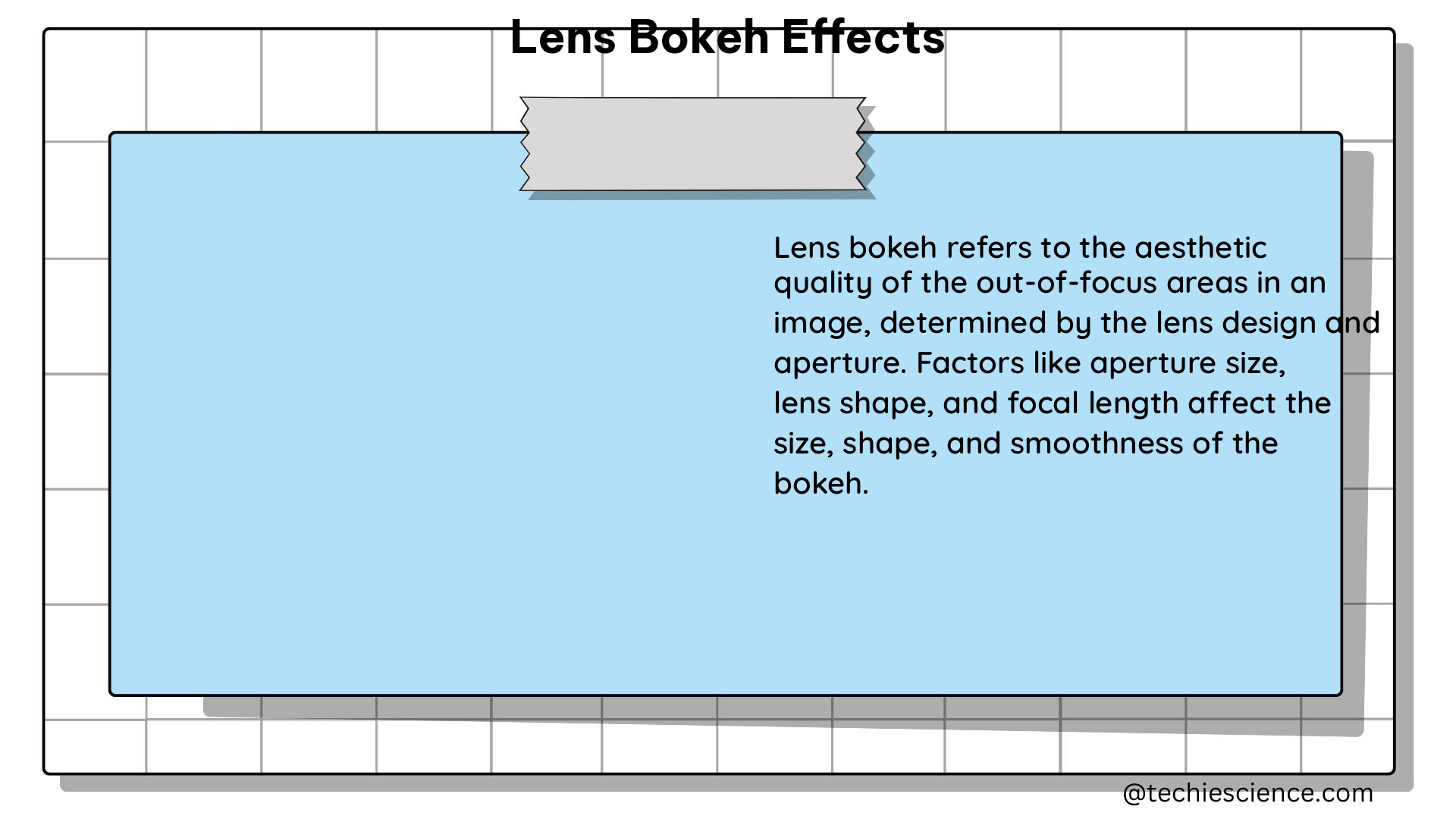Lens bokeh effects are a crucial aspect of photography, as they can significantly impact the aesthetic quality of an image. These effects are primarily determined by the aperture size and lens design, which can be quantified and analyzed using various physical principles and numerical calculations. In this comprehensive guide, we will delve into the technical details of lens bokeh effects, providing physics students with a thorough understanding of this fascinating topic.
Understanding Aperture and Bokeh
The aperture size is a fundamental factor in determining the bokeh effect. The larger the aperture, the more pronounced the bokeh effect will be, as it increases the depth of field difference between the subject and the background. This relationship can be quantified using the f-number, which is the ratio of the lens focal length to the aperture diameter.
The f-number is calculated as:
f-number = f / D
where f is the focal length of the lens, and D is the diameter of the aperture. A lower f-number indicates a larger aperture and a more pronounced bokeh effect.
Lens Design and Bokeh

In addition to the aperture size, the lens design also plays a crucial role in the bokeh effect. The number and shape of the aperture blades can significantly influence the appearance of the bokeh. Generally, more aperture blades result in a smoother, more circular bokeh effect, while fewer blades can create a more polygonal shape.
The number of aperture blades can be directly observed and counted in the lens design. The shape of the bokeh can be examined by taking photographs at various aperture settings and analyzing the resulting bokeh patterns.
The Physics of Bokeh
The physics behind the bokeh effect can be explained by the concept of the circle of confusion. The circle of confusion is the blurred image of a point source created by a lens. The size of the circle of confusion is determined by the aperture size, lens focal length, and subject distance.
The formula for the circle of confusion c is:
c = (N * u) / (f - u)
where N is the f-number, u is the subject distance, and f is the lens focal length.
A larger circle of confusion results in a more pronounced bokeh effect, as the background elements become more blurred and out of focus.
Numerical Problems and Calculations
To quantify the bokeh effect, we can calculate the depth of field and the circle of confusion for different lens and aperture combinations. Let’s consider an example:
Given a 50mm lens with an aperture of f/1.8 and a subject distance of 1 meter, we can calculate the depth of field as follows:
DOF = 2 * N * (u / f) * (f^2 + N^2 * c^2) / (N^2 * c^2 - (u - f)^2)
where N is the f-number, u is the subject distance, f is the lens focal length, and c is the circle of confusion.
Plugging in the values, we get:
DOF = 2 * 1.8 * (1 / 0.05) * (0.05^2 + 1.8^2 * c^2) / (1.8^2 * c^2 - (1 - 0.05)^2)
By adjusting the variables, such as the aperture, focal length, and subject distance, we can quantify the impact of different lens and aperture combinations on the bokeh effect.
Visualizing Bokeh Effects
To better understand the bokeh effect, it’s helpful to visualize the resulting patterns. Here are some examples of different bokeh effects:

Circular Bokeh

Polygonal Bokeh

Soft Bokeh
These images demonstrate the variety of bokeh effects that can be achieved by manipulating the aperture size and lens design.
Advanced Techniques and Research
The study of lens bokeh effects is an active area of research, with ongoing developments in computational photography and image processing. Some recent advancements include:
- Efficient Multi-Lens Bokeh Effect Rendering: Researchers have developed techniques to render realistic bokeh effects using multiple lenses, allowing for more control and flexibility in post-processing.
- Generative Bokeh with Stage Diffusion: Researchers have explored the use of generative models, such as diffusion models, to create synthetic bokeh effects that can be applied to images.
- BokehOrNot: Transforming Bokeh Effect with Image Transformer and Lens Metadata: Researchers have investigated the use of machine learning models to analyze and transform the bokeh effect in images based on lens metadata.
These advancements demonstrate the ongoing interest and progress in the field of lens bokeh effects, providing physics students with opportunities for further exploration and research.
Conclusion
In this comprehensive guide, we have explored the technical details of lens bokeh effects, covering the fundamental principles of aperture, lens design, and the underlying physics. By understanding the quantifiable aspects of bokeh, such as the f-number, circle of confusion, and depth of field calculations, physics students can gain a deeper appreciation for the science behind this captivating photographic effect.
As technology continues to evolve, the study of lens bokeh effects remains an exciting and dynamic field, offering opportunities for further research and innovation. By mastering the concepts presented in this guide, physics students can apply their knowledge to various applications, from computational photography to image processing and beyond.
References
- Efficient Multi-Lens Bokeh Effect Rendering and Transformation. (2023). Link
- Bokeh Calculation or specification? (2007). Link
- Bokeh basics and intuition from lens equations. (2008). Link
- GBSD: Generative Bokeh with Stage Diffusion. (2024). Link
- BokehOrNot: Transforming Bokeh Effect With Image Transformer and Lens Metadata. (2023). Link

The lambdageeks.com Core SME Team is a group of experienced subject matter experts from diverse scientific and technical fields including Physics, Chemistry, Technology,Electronics & Electrical Engineering, Automotive, Mechanical Engineering. Our team collaborates to create high-quality, well-researched articles on a wide range of science and technology topics for the lambdageeks.com website.
All Our Senior SME are having more than 7 Years of experience in the respective fields . They are either Working Industry Professionals or assocaited With different Universities. Refer Our Authors Page to get to know About our Core SMEs.